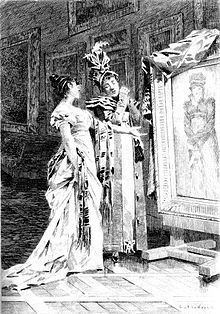7.4 /10 1 Votes7.4
Language French Originally published 1830 Followed by Letters of Two Brides Country France | 3.7/5 AbeBooks Translator Clara Bell Series La Comédie Humaine Cover artist Édouard Toudouze | |||||||||||||||||||||||||||||||||
 | ||||||||||||||||||||||||||||||||||
Genre Scènes de la vie privée Publisher Mame et Delaunay-Vallée Preceded by La firmao de la kato, kiu pilkludas Similar Honoré de Balzac books, La Comédie humaine books, Classical Studies books | ||||||||||||||||||||||||||||||||||
15 le bal de sceaux 77 scenes de la vie privee 1 honore de balzac
Le Bal de Sceaux (The Ball at Sceaux) is the fifth work of Honoré de Balzac, one of the oldest texts of la Comédie Humaine.
Contents
- 15 le bal de sceaux 77 scenes de la vie privee 1 honore de balzac
- Le bal de sceaux la com die humaine honor de balzac audiobook fr
- Analysis
- Plot
- References
The first edition of this novella was published in 1830 by Mame and Delaunay-Vallée in the Scènes de la vie privée (Scenes of Private Life). It was republished in 1835 by Madame Charles-Béchet, in 1839 in the Charpentier edition, and then in 1842 in the first volume of the Furne edition of la Comédie Humaine.
Le bal de sceaux la com die humaine honor de balzac audiobook fr
Analysis
In writing this novella Balzac seems to have been inspired by the fables of La Fontaine, especially La fille ("The Girl") and Héron ("The Heron"). There is also an allusion to La Fontaine in the choice of Émilie’s surname. The plot is similar to that of another of Balzac's works, La Vieille Fille (The Old Maid), the subject of which hesitates between several suitors and finishes by making do with the only one left.
A similar plot informs Aleksandr Pushkin's verse novel Eugene Onegin, which was published in serial form between 1825 and 1832.
Plot
After having haughtily refused a number of suitors, under the pretext that they are not peers of France, Émilie de Fontaine falls in love with a mysterious young man who quietly appeared at the village dance at Sceaux. Despite his refined appearance and aristocratic bearing, the unknown (Maximilien Longueville) never tells his identity and seems interested in nobody but his sister, a sickly young girl. But he is not insensible to the attention Émilie gives him and he accepts the invitation of Émilie’s father, the Comte de Fontaine. Émilie and Maximilien soon fall in love. The Comte de Fontaine, concerned for his daughter, decides to investigate this mysterious young man, and he discovers him on the Rue du Sentier, a simple cloth merchant, which horrifies Émilie. Piqued, she marries a 72-year-old uncle for his title of Vice Admiral, the Comte de Kergarouët.
Several years after her marriage, Émilie discovers that Maximilien is not a clothier at all, but in fact a Vicomte de Longueville who has become a Peer of France. The young man finally explains why he secretly tended a store: he did it in order to support his family, sacrificing himself for his sick sister and for his brother, who had departed the country.
